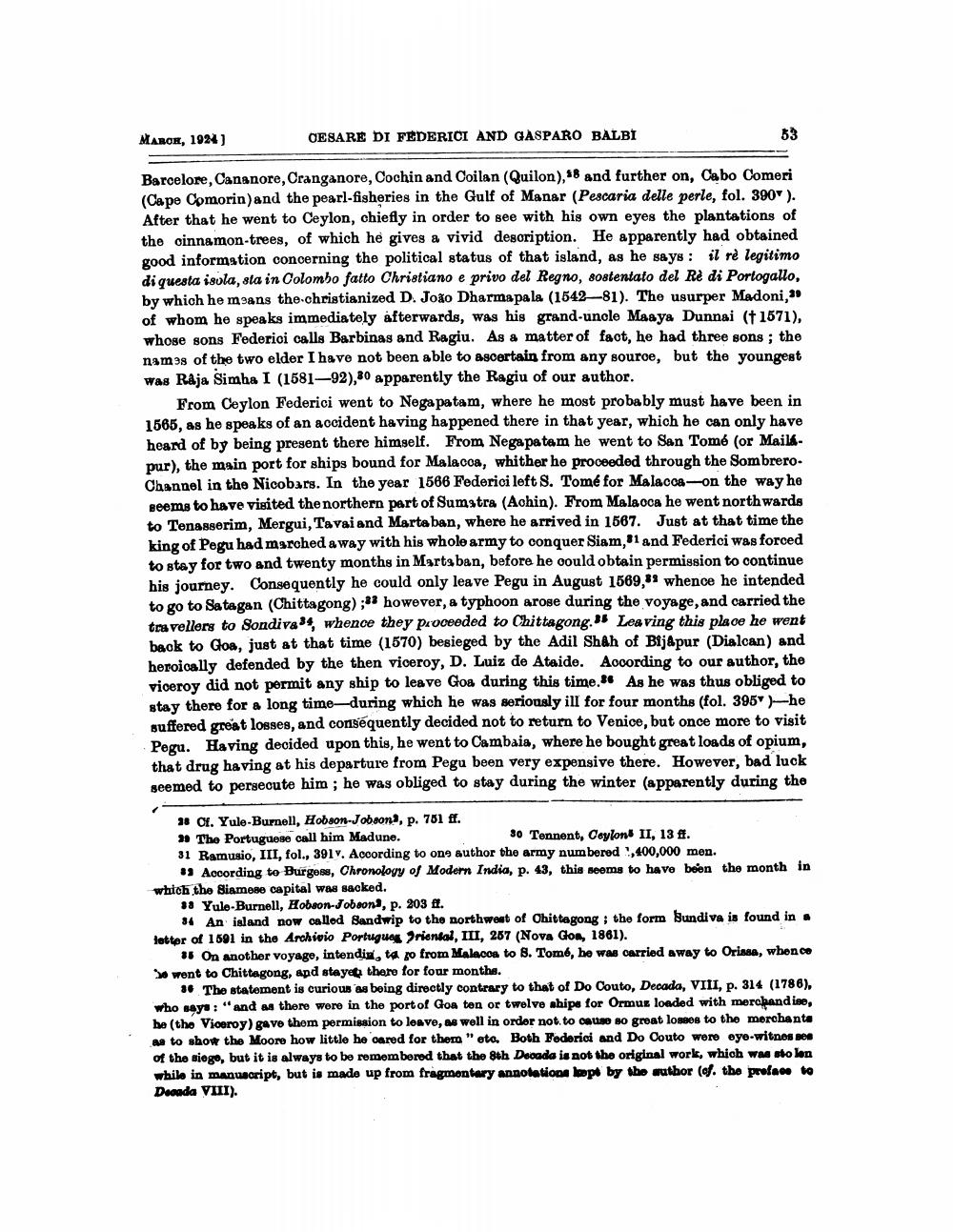________________
MABOK, 1924)
CESARE DI FEDERICI AND GASPARO BALBI
33
Barcelore. Cananore, Cranganore, Cochin and Coilan (Quilon), 18 and further on, Cabo Comeri (Cape Comorin)and the pearl-fisheries in the Gulf of Manar (Pescaria delle perle, fol. 3907). After that he went to Ceylon, chiefly in order to see with his own eyes the plantations of the cinnamon-trees, of which he gives a vivid description. He apparently had obtained good information concerning the political status of that island, as he says: il rè legitimo di questa isola, sta in Colombo fatto Christiano e privo del Regno, 808tentato del Re di Portogallo. by which he means the christianized D. João Dharmapala (1542—81). The usurper Madoni, of whom he speaks immediately afterwards, was his grand-unole Maaya Dunnai (t1571), whose sons Federici calls Barbinas and Ragiu. As a matter of fact, he had three sons; the nams of the two elder I have not been able to ascertain from any souroe, but the youngest was Raja Simba I (1581-92), 30 apparently the Ragiu of our author.
From Ceylon Federici went to Nega patam, where he most probably must have been in 1565, as he speaks of an accident having happened there in that year, which he can only have heard of by being present there himself. From Nega patam he went to San Tomé (or Mailspur), the main port for ships bound for Malacoa, whither he proceeded through the Sombrero. Channel in the Nicobars. In the year 1566 Federici left S. Tome for Malacca-on the way he seems to have visited the northern part of Sumatra (Achin). From Malacca he went northwards to Tenasserim, Mergui, Tavai and Marta ban, where he arrived in 1567. Just at that time the king of Pegu had merched away with his whole army to conquer Siam, 11 and Federici was forced to stay for two and twenty months in Mortsban, before he could obtain permission to continue his journey. Consequently he could only leave Pegu in August 1569," whence he intended to go to Satagan (Chittagong); however, a typhoon arose during the voyage, and carried the travellers to Sondiva 34, whence they proceeded to Chittagong." Leaving this place he went hack to Goa just at that time (1670) besieged by the Adil Shah of Bijapur (Dialcan) and heroically defended by the then viceroy, D. Luiz de Ataide. According to our author, the viceroy did not permit any ship to leave Goa during this time. As he was thus obliged to stay there for a long time-during which he was seriously ill for four months (fol. 395)-he Buffered great losses, and conséquently decided not to return to Venice, but once more to visit Pegu. Having decided upon this, he went to Cambaia, where he bought great loads of opium. that drug having at his departure from Pegu been very expensive there. However, bad luck seemed to persecute him; he was obliged to stay during the winter (apparently during the
38 of. Yule-Burnell, Hobson-Jobsona, p. 781 ff. » The Portuguese call him Madune.
80 Tennent, Ceylond II, 13 ft. 31 Ramusio, III, fol., 391V. According to one author the army numbered 1,400,000 men.
03 According to Burgos, Chronology of Modern India, p. 43, this seems to have been the month in which the Siamese capital was sacked.
38 Yulo-Burnell, Hobson-Jobson), p. 203 it.
34 An island now called Sandwip to the northwest of Chittagong : the form bundiva is found in letter of 1691 in the Archivio Portugues Oriental, III, 267 (Nova Gon, 1861).
18 On another voyage, intendix, to go from Malacoa to 8. Tomé, he was carried away to Orissa, whence So went to Chittagong, and stayed there for four months.
** The statement is curious as being directly contrary to that of Do Couto, Decada, VIII, p. 314 (1786). who says: "and as there were in the port of Goa ten or twelve ahipe for Ormus loaded with merchandise, be (the Viceroy) gave them permission to leave, as well in order not to cause so great losses to the merchanta as to show the Moore how little he cared for them " etc. Both Foderic and Do Couto were oyo-witnesses of the siogo, but it is always to be remembered that the 8th Decada is not the original work, which was stolon while in manuscript, but is made up from fragmentary annotations loop by the rathor of the proface to Deoada VIII).




